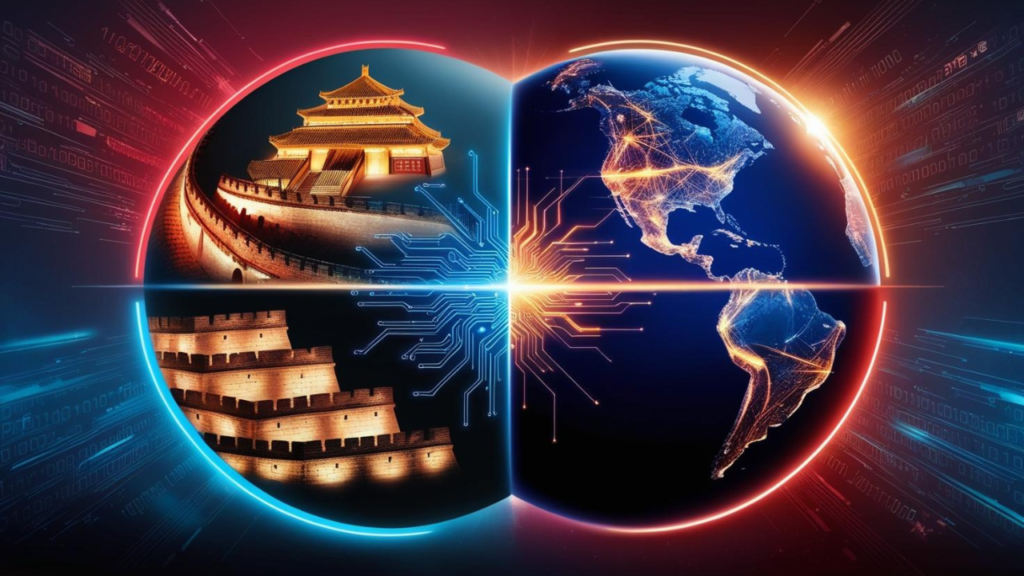This article explores the escalating AI competition between China and the U.S., highlighting key aspects such as government control, efficiency breakthroughs, and the broader implications for the global AI landscape

Introduction The competition between China and the United States in artificial intelligence (AI) development is intensifying, shaping the future of technology, economics, and global influence. While the U.S. leads in cutting-edge innovation, China is leveraging efficiency and cost-effectiveness to challenge the status quo. This article explores the critical aspects of the AI rivalry, including government regulations, hardware limitations, model efficiency, and the broader implications for the world.
China’s State-Controlled AI Development China’s AI industry operates under strict government oversight, ensuring that all AI-generated content aligns with “core socialist values.” Major tech companies like Tencent and Alibaba develop models that conform to the ideological guidelines set by the Chinese Communist Party (CCP). This control leads to censorship of politically sensitive topics, such as:
- The Tiananmen Square Massacre (1989): AI models omit or deny discussions related to the pro-democracy protests.
- Human Rights Abuses: Mentions of issues like the treatment of Uyghur Muslims and restrictions on freedom of speech are suppressed.
- Criticism of Political Leaders: Negative commentary about President Xi Jinping and the CCP is filtered or redirected.
The AI Race: Democratic vs. Autocratic Approaches The AI competition between China and the U.S. presents a contrast between two development models:
- Democratic AI: Prioritizes transparency, ethical considerations, and freedom of expression.
- Autocratic AI: Serves government agendas, controls information, and reinforces political ideologies.
If China’s AI models gain global traction due to their affordability and efficiency, it could influence the AI landscape, potentially leading to an erosion of trust in AI-generated content worldwide.
Hardware Constraints Driving Chinese Innovation U.S. sanctions have limited China’s access to advanced AI hardware, such as NVIDIA H100 GPUs, essential for training large-scale models. In response, Chinese developers have focused on optimizing AI models to work with older, less powerful hardware. This necessity-driven innovation has resulted in:
- Efficient AI Models: Achieving competitive performance with significantly fewer resources.
- Reduced Training Costs: Producing high-quality models at a fraction of Western training budgets.
- Performance Benchmarks: Matching or exceeding Western models in some areas despite hardware limitations.
Breakthroughs in AI Efficiency Chinese AI models have demonstrated exceptional efficiency by achieving significant cost reductions and performance improvements. Some key achievements include:
- Resource Optimization: Training powerful models with only 2,048 GPUs, significantly fewer than Western counterparts.
- Cost-Effectiveness: Developing high-quality models for as little as $5 million, much lower than typical Western investments.
- High-Speed Token Generation: Delivering outputs at speeds of 16 to 60 tokens per second, making them scalable and attractive.
China’s Open-Source Strategy vs. U.S. Approaches China has surprised the global AI community by releasing high-quality models as open-source. This move fosters innovation worldwide and challenges the dominance of Western firms like Meta, OpenAI, and Anthropic.
Key comparisons:
- China’s Models: Offer cost-effective alternatives that are “10x cheaper” than GPT-4 and “15x cheaper” than smaller Western models.
- U.S. Models: While leading in performance, they face increasing pressure to improve efficiency and affordability.
Challenges for U.S. AI Leadership Despite access to superior resources, U.S. AI companies face mounting pressure to enhance efficiency and cost-effectiveness to stay competitive. Strategic considerations include:
- Balancing Power and Efficiency: Learning from China’s optimization strategies.
- Maintaining Technological Lead: Ensuring continued leadership without compromising ethical values.
The Future of AI: Global Implications The ongoing AI race between China and the U.S. has far-reaching consequences beyond technology. It influences global economic dynamics, national security, and the ideological balance of power. Key takeaways include:
- Geopolitical Stakes: The winner of the AI race could shape global governance and information control.
- Ethical Considerations: Developers worldwide must prioritize ethical AI deployment over cost-efficiency.
- Strategic Decisions: The U.S. must consider integrating efficiency lessons from China while maintaining its democratic values.
Conclusion The AI rivalry between China and the United States is a defining challenge of our time. China’s efficiency-driven approach threatens to disrupt the AI landscape, while the U.S. must strike a balance between power and optimization. As AI continues to evolve, its impact on society, governance, and the global economy will only grow.


